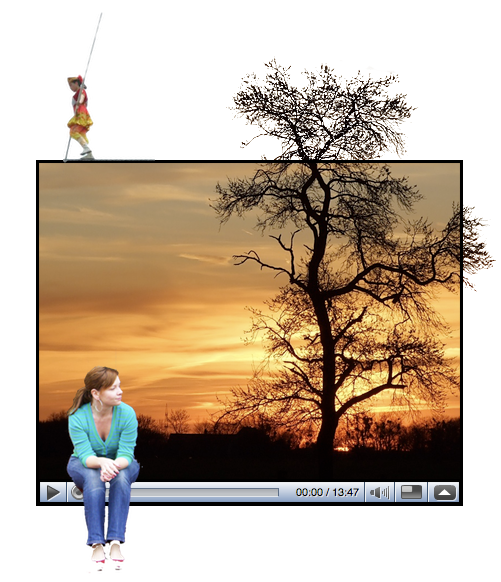The Turmoil in the Industry: Part Three

In the last two posts I have covered the challenges facing our industry – financing its films when the distribution model is defunct, monetizing the Internet where users expect to pay nothing, and conquering the crowd logic of moviegoers and the advertising budgets of the big players.
The situation seems dire, but I see a glimmer hope for indie filmmakers. If we follow some currently existing technologies to investigate the possibilities they create, we can see glimpses of a future that is ever more friendly to the independent filmmaker. Here are the changes I see happening – if you have any thoughts don’t be shy about commenting!
Lowered cost of film production
There is no arguing this one – films are cheaper to make than ever, and costs are only going down. With a Filp camera and a Mac with Final Cut, anybody can create a feature film in HD. Of course availability does not equal quality; there is little chance of competing with a studio film if money and creative energy are spent on lighting, film and acting talent, set design, etc. Still, the cost of making a great movie with a small, scrappy team is dropping astronomically.
This means that studios will have a much harder time competing quality-wise with independent productions. Still, they maintain three advantages that they are unlikely to lose. First, they have greater financial resources and the ability to take risk – they can recoup losses from some films with profits from successful films. Second, they have greater access to movie stars and money to pay for them, and this access will always be useful. Third, they have the ability to make huge-budget crowd-pleasing effects movies like Transformers and Batman. These are the films that benefit the most from effects budgets, licensing deals, and traditional marketing that can get an entire country excited for the release.
Internet marketing
Again, already begun. The Internet has allowed filmmakers more opportunity than ever before to reach the exact audience that will be interested in their film. This process is already creating successes of movies that would have been failures ten years ago.
This ability to get the word out is important, but I see it as a first step. At this point, film networks are ad-hoc and created by the filmmaker – a website and Facebook page that collects email addresses and sends updates, for example. I am more interested in communities that already exist for the express purpose of movie watching.
What’s more, these communities can be tied to the actual distribution of films. For example, a moviegoer can log onto a website that provides not only showtimes and trailers, but a viewer community, links to similar films, and rankings of films. Furthermore, the performance of a film on these sites can inform the distribution of films; films that perform well can be featured more prominently at physical box-office locations.
Does this sound familiar? It’s a model already in use..read on.
Digital distribution of films
This is certainly coming, and it’s implications are enormous. Currently, a 35mm print must be struck for every film exhibition run–a time-consuming and costly process. The costs of transporting these prints and coordinating their locations for a theatrical run are very daunting for small distributors. These limitations are most of the reason for our current model: films make either a small run at festivals or a huge nationwide run, with very little in the middle.
Digital distribution will change all that. With digital projectors and high-speed data connections, any movie theater can pay for an exhibition license with a credit card and download the film to its projectors. So any filmmaker with enough enterprise can convince a theater to show a film just once. Films can have medium-sized distribution runs. Films can be show at off hours and, if they perform well, moved to peak hours. The development opens the door for all manners of promotion: for example, a filmmaker can give a screening to a theater for free to show the movie’s viability and then charge for successive screenings.
Even as home distribution rises, there will always be an appetite for showing and watching films in large groups, and this large-format distribution will finally be in on the digital game.
Flattening of the exhibition curve
The curve I discussed earlier, plotting the popularity of a film against the number of times it has been watched, drops precipitously after the first few studio films. As independent films are easier to promote and distribute, this curve will flatten substantially and non-studio films will win a greater audience. With lower barriers to every element of filmmaking, smaller entities will be able to make money off their films, and maybe have a better shot at making it big.
This brave new world offers a different role for studios. The astronomical profits of big hits are likely to shrink, and with them a lot of the sexy status and extreme wealth of the film industry. I don’t think the industry will have the same tremendous skew of wealth distribution as it currently does, with billion-dollar success stories and bucketloads of cheap labor – it will begin to resemble much less of a glamor industry and more a traditional one (Malcom Gladwell has a great illustration of this distinction in The Tipping Point.) Studios will have incentive to invest in many low-budget films; we will likely see much of the independent film market be assimilated and funded by the studios — niche films, political films, and all the rest.
The change in the curve also will make low-budget filmmaking a less risky endeavor. A filmmaker will have a more easily accessible source of revenue in the new digital cinemas, and further revenue in the form of…
The rise of micropayment
Micropayment is simply the process of paying small amounts of money – from $.10 to $2 or so, in exchange for information or anything else. It’s already here but it has not reached maturity, and I believe that payments of small amounts of money can save this and other industries.
The capability is here – any website that wants to can accept a credit card in return for a service, but these sites currently face two obstacles. The first is effort – entering a credit card number and confirming billing information takes a good amount of time; sites like the iTunes Store show much more success by taking credit card information in the beginning. This way, purchases become as easy as a single click. It is easy to spend a dollar here, 50 cents there, without thinking too much about it.
I see payment becoming integrated into our browser sessions and various user accounts automatically and across the board. A user can perform a single click and the browser will take care of the rest. There is plenty of research into secure means of achieving this goal, and I am confident we can iron out the kinks.
Once this procedure is perfected, I predict that news and video sites will start charging for content again – I don’t know what model they will use, but 30 cents for a news article would be a big change from free information. Once consumers are used to paying in micropayments, the possibilities for content providers are endless. A person can pay $2 to watch the first 30 minutes of a film and another $6 to watch the rest of it if they like it, for example.
A note on copy protection
The next issue with micropayment for films is copy protection. I fundamentally disagree with the concept of copy protection and locking media to a specific device. I have frequently circumvented copy protection just to be able to exercise my legal fair-use rights, and I resent the cage my media has been placed in. Still, some form of content protection is required if a filmmaker is to make money. Also recognizing that someone will figure out how to pirate your movie somehow, what makes most sense to me is a very light form of protection that deters casual copying; there is no justification in trying harder than that.
All these factors bring me to my big-deal solution that I believe will be the next revolution in film distribution. I call it..
The Youtubization of Feature Films
I told you that the centralized viewing model I described was a familiar one, and it is – it’s almost the exact model of YouTube, but with feature films! Once films can be uploaded to a network, sold at small cost to individuals and large cost to theaters, and people can enter in an online community as a part of that network, this shift will be inevitable. On top of this framework, a million different pricing and exhibition options are available – distribution from movie screens all the way down to cell phones, all through the same mechanism. A filmmaker can set the prices and for each distribution
The consequences here are enormous. In this framework, the content, promotion, and distribution are one and the same. A frequently-watched trailer will earn higher placement on the site and entice theater owners to choose that film to exhibit. Movies will be able to “go viral” much in the same way short videos have: by making money in a limited theatrical run, getting many online views, etc. Even the smaller films will be able to develop their own communities as part of the greater movie-watching community.
This shift will bring tremendous diversity to the moviegoer experience. In New York, we enjoy a population density so great that it sustains many independent theaters and offers New Yorkers plenty of choice. Soon, any town with a multiplex will be able to offer a similar diversity. The cost of doing so will be nominal.
With this diversity, I predict that as more obscure content becomes more psychologically acceptable and available, viewers will become more empowered to choose movies and more active in their movie choices. I hope, in my lifetime, to see non-cinephiles give an obscure documentary the same consideration as a large-budget action feature. Perhaps this dream is too optimistic, but I know we are heading towards it.
And so we have come full circle
From the days of storytelling before books and the radio, when wandering storytellers would gather groups by fire or candlelight to tell their tales, we are heading back towards where we came. Peer-to-peer storytelling is now a reality–and while only the good storytellers are successful, it’s nice to see that everyone can have a chance.
